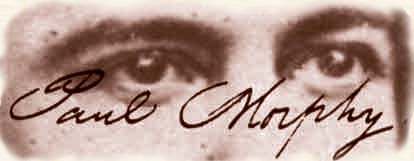

| THE LIFE AND CHESS OF PAUL MORPHY Howard Staunton |
Howard Staunton
|
1843 was a busy year for Staunton. He played a match with Henry Thomas Buckle,
spotting Buckle odds of Pawn & move. The first game was drawn, Buckle won
the next six. Next he played John Cochrane two matches. The first, giving
Cochrane, Pawn & move, ended in a draw with each winning three game. The
second match, played on even terms, Cochrane won with two draws and three wins
versus Staunton one win. Staunton then played a short match with the French
champion, Saint Amant. Saint Amant won this match (and one guinea) +3 -1 =2.
Around 1840, the Westminster club had closed for a second time. Aaron Alexandré had establish a chess café in Paris called the Café de l'Echiquiér, hoping to survive by gaining members from the more established Cafés de la Régence et de Procope, but instead failed almost immediately after opening. Upon meeting Staunton, Alexandré suggested they open an establishment together, which they did at the exclusive Waterloo Chambers. They immediately added about 30 members to the role, but before a year was up, Staunton and Alexandré had disagreements that became so nasty the members themselves requested the Club be dissolved. George Walker secured a site at Beatties Hotel on George Street and these members formed the St. George's Club there. Beattie's business failed and the St. George's Club moved to the Polytechnic Institution on Regent Street. This is where Staunton played his first match with Saint Amant. Some time after its creation, Staunton became an honorary member of the club in deference to his position in English chess. Staunton took over as chess columnist for the Illustrated London News in February of 1845, a position he would hold the rest of his life. Just two months later, Staunton and Capt. Kennedy (Hugh Alexander Kennedy will also happen to lose the first international telegraphic game to Serafino Dubois in 1862), sending their moves from the Portsmouth suburb of Gosport, played two consultations games against "a group of players at the London Vauxhall railway terminus" via telegraph (This group of player was comprised of Evans, Perigal, Tuckett, and Walker - with Buckle kibitzing). The first telegraph match took place in America in 1845 when Washington played Baltimore; this was the first telegraph match in England. The quality of the games was poor. Both ended in draws. But they were more intended for the sake of the experiment rather than the result. In 1846 Staunton beat both Bernhard Hörwitz (+14 =3 -7) and Daniel Harrwitz in matches. Neither players were considered particularly strong at that time. The match with Harrwitz was unusual, as were the results - a total of 21 games: 7 at Pawn & 2, won by Staunton 4-3; 7 at Pawn & move, won by Harrwitz 6-1; and 7 even, won by Staunton 7-0.
Staunton married Frances Carpenter
Nethersole on July 23,1849.
"A set of Chessmen, of a pattern combining elegance and solidity to a degree hitherto unknown, has recently appeared under the auspices of the celebrated player Mr. STAUNTON. A guiding principle has been to give by their form a signification to the various pieces - thus the king is represented by a crown, the Queen by a coronet, &c. The pieces generally are fashioned with convenience to the hand; and it is to be remarked, that while there is so great an accession to elegance of form, it is not attained at the expense of practical utility. Mr. STAUNTON'S pattern adopts but elevates the conventional form; and the base of the Pieces being of a large diameter, they are more steady than ordinary sets." London was sponsoring the Great Exhibition of 1851. Staunton had the idea to hold a tournament in conjunction with the event. His idea went further than just a tournament. He wanted a grand tournament bringing in chess experts from all over the globe. The first international chess tournament was held in London from May to July of 1851. It was won by Adolf Anderssen. Staunton took a distant fourth. But that same year, he won matches against Carl Friedrich Von Jaenisch from Russia (+7 -2 =1) and from Elija Williams of England (+6 -4 =1). In 1853 Staunton traveled to Brussels, Belgium to confer with Baron Tassilo von Heydebrand und der Lasa about the standardization of chess rules. They played a match which Lasa won (+5 -4 =3).
Staunton's Books on Shakespeare: The Complete Works of William Shakespeare The Globe Illustrated Shakespeare: The Complete Works AnnotatedOriginally published: The plays of Shakespeare. London : G. Routledge, 1858-1861
Complete Illustrated Shakespeare Paul Morphy's opinion of Howard Staunton as a chess-player
1847 - The Chess-player's Handbook: A Popular and
Scientific Introduction to the Game of Chess, Exemplified in Games
Actually Played by the Greatest Masters, and Illustrated by Numerous Diagrams of
Original and Remarkable
Positions
Howard Staunton April 1810 - June 22, 1874 Actor, Shakespearian Scholar, Chess Champion of England, Architect of the First International Chess Tournament, held in London1851, Author of The Chess-Player's Handbook and The Chess-Player's Companion, Kensal Green Cemetery, London, England |